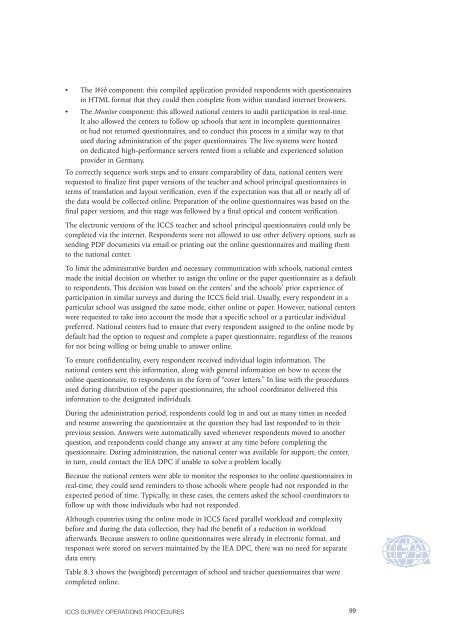ICCS 2009 Technical Report - IEA
ICCS 2009 Technical Report - IEA
ICCS 2009 Technical Report - IEA
- No tags were found...
You also want an ePaper? Increase the reach of your titles
YUMPU automatically turns print PDFs into web optimized ePapers that Google loves.
• The Web component: this compiled application provided respondents with questionnairesin HTML format that they could then complete from within standard internet browsers.• The Monitor component: this allowed national centers to audit participation in real-time.It also allowed the centers to follow up schools that sent in incomplete questionnairesor had not returned questionnaires, and to conduct this process in a similar way to thatused during administration of the paper questionnaires. The live systems were hostedon dedicated high-performance servers rented from a reliable and experienced solutionprovider in Germany.To correctly sequence work steps and to ensure comparability of data, national centers wererequested to finalize first paper versions of the teacher and school principal questionnaires interms of translation and layout verification, even if the expectation was that all or nearly all ofthe data would be collected online. Preparation of the online questionnaires was based on thefinal paper versions, and this stage was followed by a final optical and content verification.The electronic versions of the <strong>ICCS</strong> teacher and school principal questionnaires could only becompleted via the internet. Respondents were not allowed to use other delivery options, such assending PDF documents via email or printing out the online questionnaires and mailing themto the national center.To limit the administrative burden and necessary communication with schools, national centersmade the initial decision on whether to assign the online or the paper questionnaire as a defaultto respondents. This decision was based on the centers’ and the schools’ prior experience ofparticipation in similar surveys and during the <strong>ICCS</strong> field trial. Usually, every respondent in aparticular school was assigned the same mode, either online or paper. However, national centerswere requested to take into account the mode that a specific school or a particular individualpreferred. National centers had to ensure that every respondent assigned to the online mode bydefault had the option to request and complete a paper questionnaire, regardless of the reasonsfor not being willing or being unable to answer online.To ensure confidentiality, every respondent received individual login information. Thenational centers sent this information, along with general information on how to access theonline questionnaire, to respondents in the form of “cover letters.” In line with the proceduresused during distribution of the paper questionnaires, the school coordinator delivered thisinformation to the designated individuals.During the administration period, respondents could log in and out as many times as neededand resume answering the questionnaire at the question they had last responded to in theirprevious session. Answers were automatically saved whenever respondents moved to anotherquestion, and respondents could change any answer at any time before completing thequestionnaire. During administration, the national center was available for support; the center,in turn, could contact the <strong>IEA</strong> DPC if unable to solve a problem locally.Because the national centers were able to monitor the responses to the online questionnaires inreal-time, they could send reminders to those schools where people had not responded in theexpected period of time. Typically, in these cases, the centers asked the school coordinators tofollow up with those individuals who had not responded.Although countries using the online mode in <strong>ICCS</strong> faced parallel workload and complexitybefore and during the data collection, they had the benefit of a reduction in workloadafterwards. Because answers to online questionnaires were already in electronic format, andresponses were stored on servers maintained by the <strong>IEA</strong> DPC, there was no need for separatedata entry.Table 8.3 shows the (weighted) percentages of school and teacher questionnaires that werecompleted online.<strong>ICCS</strong> SURVEY OPERATIONS PROCEDURES99
















